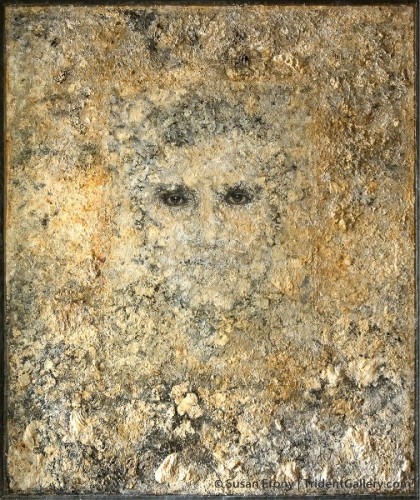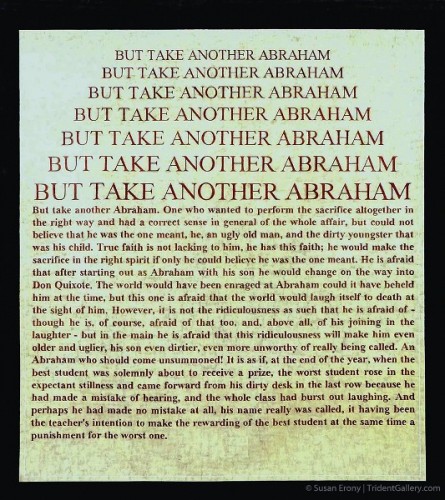Susan Erony’s Redeeming Pessimism
Trident Gallery Gloucester, Mass.
By: Matthew Swift - Sep 12, 2014
Two things fill the mind with ever-increasing wonder and awe, the more often and the more intensely the mind of thought is drawn to them: the starry heavens above me, and the moral law within me.
Immanuel Kant
Following the well-known pronouncement of Kant’s which couples the conscience within us with the starry heavens, a pious man might well be tempted to honor these two things as the masterpieces of creation. The stars are indeed magnificent, but as regards conscience God has done an uneven and careless piece of work.
Sigmund Freud
Among its other serious engagements, Susan Erony’s art takes a place of honor within a long tradition of pessimism, the body of thought and art by those who are persuaded that there is more suffering in the world than bliss, more evil than good.
Artists and philosophers have taken various roads to the dark forest of pessimism, but Erony arrives along a well-travelled path which originates in a surfeit of sensitivity and empathy — a surfeit of those qualities which convention recognizes generally to be essential in artists.
Pessimism is not a blindered vision, unable to see good in the world; it is a wide view with a lingeringly steady gaze at a world from which many of us flinch sooner than Erony. That we do all flinch, eventually, is the fact at the heart of why we need this kind of art. Those with keen sensitivities and quick tears are the bravest, the last to flinch, and they can feel justifiably offended when they are depreciated for their heightened awareness:At a party an English intellectual — so-called — asked me why I write always about distress.
As if it were perverse to do so!.... I left the party as soon as possible and got into a taxi. On the glass partition between me and the driver were three signs: one asked for help for the blind, another help for orphans, and the third for relief for the war refugees. One does not have to look for distress. It is screaming at you even in the taxis of London.
Samuel Beckett in an interview. Art that confronts distress compels us to examine and to cherish anew our ideas of comfort, justice, and good conduct, which take their shape, their importance, and their imperative from unflinching apprehension of suffering and evil, from unstinting empathy with the downtrodden and the disappeared. Without attention to these dark shadows, those of us in the bright sunshine of safety and well being risk the spiritual impoverishment of callousness, in which desires become trivial as the capacity for empathy atrophies. In callousness, love loses its importance and beauty its splendor.
The paths to that forest begin with the earnest proposition — older than history, and more central to more traditions of spiritual thought than may at first seem apparent — that the
human condition is one of exile from grace. The familiar story in the Book of Genesis tells of the fall of humankind and its expulsion from Eden, which is the origin, according to many interpretive traditions, of human mortality and the burden of original sin (inherited sinfulness or the tendency to sin, that is, to stray further from grace). Other cultures tell narratives having the same essential proposition, one profound consequence of which is to structure the idea of meaningful life as a narrative of return and restoration, a narrative of redemption.
There remains of course room to question and to discover for oneself the height of the fall, what was lost as a result, what new perils lurk in the wilderness, and which stars to follow to find the way home. In her commentary on Where in the World, Erony describes a moment of personal recognition, now memorialized in her four panels, when for her the balance tipped and she posed herself the question, “Where in the world did I ever get the idea that people were supposed to be good?”
This gentle and self-deprecating indictment of human nature suggests that Erony is a lapsed optimist, one who has concluded only with reluctance that ours is not the best of possible worlds. Compare the vehemence of the deeply committed pessimist Schopenhauer, who wrote that optimism, when it is not merely the thoughtless talk of such as harbour nothing but words under their low foreheads, appears not merely as an absurd, but also as a really wicked way of thinking, as a bitter mockery of the unspeakable suffering of humanity. (I.iv.420)
The reflexive response to psychic pain or horror is to withdraw from confronting it, to recoil, close off the senses, seek refuge. When Thomas Hardy’s Tess confronts rejection by her new husband on her wedding night, following her confession that she had once been raped and borne a child (who lived but briefly), she falls asleep, alone. The narrator comments that when sorrow ceases to be speculative, sleep sees her opportunity.
When George Eliot’s Dorothea in Middlemarch confronts the realization that her new husband is, in the words of another character, a “dried-up pedant,” the narrator reflects on the human necessity to be insensitive to everyday sorrows, regardless of their power, exactly because of their frequency: Some discouragement, some faintness of heart at the new real future which replaces the imaginary, is not unusual, and we do not expect people to be deeply moved by what is not unusual. That element of tragedy which lies in the very fact of frequency, has not yet wrought itself into the coarse emotion of mankind; and perhaps our frames could hardly bear much of it. If we had a keen vision and feeling of all ordinary human life, it would be like hearing the grass grow and the squirrel’s heart beat, and we should die of that roar which lies on the other side of silence. As it is, the quickest of us walk about well wadded with stupidity.
Self-protection is an indispensable function, but when sleep and withdrawal become habitual or elevated into a principle of non-engagement, it is no more than self-absorption. Withdrawal is in any case ineffective as an enduring strategy: the palace of the mind, while tempting, is an illusory refuge. Milton’s Satan, cast by God from Heaven into Hell, arrives with high expectations of his ability to disregard the miserable place: The mind is its own place, and in it self Can make a Heav’n of Hell, a Hell of Heav’n.
What matter where, if I be still the same, His folly soon becomes clear to him, however: “Which way I flie is Hell; my self am hell.” One can close one’s eyes to the world, but not escape sorrow: the human eyelid is not teartight.
Erony’s unseeing eyes, unspeaking lips is a profound work of art about the contrary imperatives of emotional safety and moral awareness, and about the practical dilemma of when to feel and when to shun feeling. The rosy beauty in this painting seduces us, as surely Erony intends. Spend time with it, and before long, the fresh entrails on blackened ashes — a burnt offering, a sacrifice, an image of the pyres of Treblinka — or else an image of a mind stripped of its sensibilties: a brain stripped of its organs of sensing — before long, I say, one forgets to see the carnage (even as it thickly protrudes off the canvas), and disgust gives way to the appreciation of beauty. The most confrontational piece in this exhibition may also be the most beautiful — lips and eyes in starry array, fringing into gorgeous depths of space. Through this stark contrast of moral ugliness and visual beauty, unseeing eyes, unspeaking lips invites and allows us to experience directly and self-consciously the contrary consequences of art’s transmuting mediation between the viewer and the world: that is, to experience both art’s welcome capacity to provide a safe or at least more tolerable means of encountering difficult truths, and simultaneously to experience art’s complicity with that flinching part of human nature which recoils into the comforts of falsification and the safety of disengagement.
The space opened up in between those contraries, through the activity of aesthetic contemplation, is where Schopenhauer finds redemption. The stars above him — an emblem, if not the actual locale, of the reliable permanence of a Christian God’s love and a millenial redemption in the afterlife, those same stars which sustained and guided faithful pilgrims for centuries from Dante to Kant — no longer inspired or comforted this philosopher. His more modern age sought redemption for the living, and in his view the sole path to “that perfect calm of the spirit, that deep rest” is detached contemplation requiring extreme sensory withdrawal from the tyrannical material world, a radical idealism in which our world, which is so real, with all its suns and milky ways — is nothing.
Not all who admired and studied this great philosopher were ready to discard the old ghosts, however. Kafka and Beckett, directing mirthless laughter at unhappiness, found precedent in those Old Testament stories of faithful men tested sorely by God. Kafka’s parable “On Abraham” confronts old questions of justice, humility, and suffering, which gain a new dimension of force through Erony’s post-Holocaust reiteration in.
But Take Another Abraham. And the story of Job is an enduring parable for Beckett’s characters in search of available redemption, none more poignant than Macmann in this passage of the novel Malone Dies, who finds it in a smile and the memory of stars. Having time to think while lying prone on the ground to wait out a rain, the idea of punishment came to his mind.... And without knowing exactly what his sin was he felt full well that living was not a sufficient atonement for it or that this atonement
was in itself a sin, calling for more atonement, and so on, as if there could be anything but life, for the living. And no doubt he would have wondered if it was really necessary to be guilty in order to be punished but for the memory, more and more galling, of his having consented to live in his mother, then to leave her. And this again he could not see as his true sin, but as yet another atonement which had miscarried and, far from cleansing him of his sin, plunged him in it deeper than before. And truth to tell the ideas of guilt and punishment were confused together in his mind, as those of cause and effect so often are in the minds of those who continue to think. And it was often in fear and trembling that he suffered, saying, This will cost me dear. But not knowing how to go about it, in order to think and feel correctly, he would suddenly begin to smile for no reason, ... for already it is long since that afternoon ... when the rain caught him far from shelter, to smile and give thanks for the teeming rain and the promise it contained of stars a little later.
The summer of 2014 has brought a steady torrent of news of human misery and depravity: civilian flights missing and downed; riot, war, and virulent disease in Ferguson, Gaza, Liberia, Ukraine; beheadings in the Levant; and innocent men with the minds of children jailed for thirty years in Raleigh. One does not have to look for injustice and unjustifiable suffering, it is screaming at us from our radios, televisions, newspapers, magazines, computer screens, and mobile devices.
We are goaded with renewed sharpness by the horns of an old dilemma. “Enough!” we cry out, “or Too much.”
We resist. And at the same time, the strident news penetrates our customary wadding, rekindles our awareness of peril, suffering, and depravity, and renews a sense of responsibility to offer relief and comfort to the afflicted, to bear witness, and to speak and act against injustices and destruction.
In such a time as this especially, we need art like Kafka’s, Beckett’s, and Erony’s. We need the keen sensitivites and pained consciences of the tradition of pessimism to stand unflinching at the boundaries of the tolerable and be for us that gentle wadding admitting and transmuting, detoxifying what we need to see and what we ought to remember; to tutor our “uneven and careless” consciences; to help us to remain alert to the full range of experiences of life, lest we be sensible to nothing of value; and to keep in front of us the beauty and essential holiness of the self that wishes to be spared suffering, and wishes to spare it for others.
Susan Erony’s commentary on her painting Listening Ritual describes the rituals that surrounded the making of it: she modulated between listening to the news of the day, and
listening to the voices of conscience, knowledge, and history. “I believe that art can save the world,” she has said. “I expect still in my heart that if one sees a great painting that one will become enlightened, and that’s what keeps me going.” From this painting let us be inspired to adopt and maintain our own listening rituals: rituals of attention, of tenderness, of necessary defense, of contemplation of art — rituals of redemption.
Trident Gallery
189 Main Street
Gloucester, Mass 01930978 491 7785
September 5 to October 5, 2014




